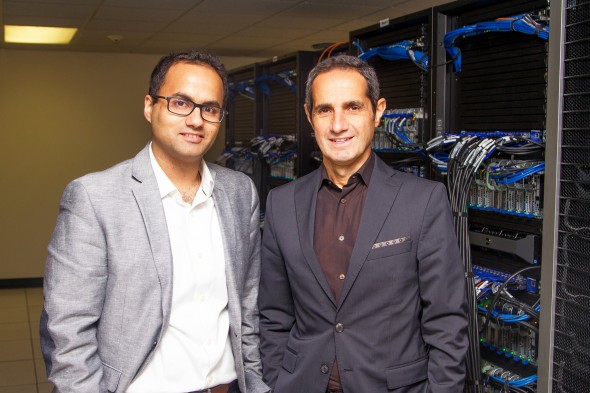East Meets West: SABER builds campus computing backbone

UIC researchers Himanshu Sharma (left) and Farzad Mashayek are among collaborators on the SABER computing project. (Photo: Vibhu S. Rangavasan)
In the last six months, UIC has received two grants for major research instrumentation and campus cyber-infrastructure from the National Science Foundation totaling $1.1 million that together will build the computing backbone for big-data mining and high-performance computing and sharing across all disciplines on campus.
Researchers and centers in nine colleges across the east and west sides of campus have presented use-cases for the new equipment, which will be called SABER, for “Shared Analytics and Big-data Enterprise Resource.”
SABER will build upon a legacy of high-performance computing (HPC) clusters at UIC, which brought together a community of researchers to share resources and know-how, according to the project leaders.
“Now, UIC has the expertise to put together such a system,” said Farzad Mashayek, professor and head of mechanical and industrial engineering, and principal investigator on the new grants. That expertise, he said, was gained on the earlier clusters that diverse departments and researchers cobbled together using university funds and the grant funds of individual investigators.
In the early years of the new millennium, to provide campus users with the ability to execute programs in parallel, UIC’s Research Computing group at ACCC constructed the university’s first open-access cluster, called Argo, using 57 inexpensive, off-the-shelf computers. That cluster was recently decommissioned, having been superseded in 2013 with the acquisition of an HPC cluster called EXTREME, a so-called “condo,” or user-owned machine. The cluster was a result of efforts by UIC’s IT Governance Council Research committee, which sought funding from the Office of the Provost, Office of the Vice Chancellor for Research, ACCC, colleges and investigators, who collectively paid for the hardware while the university covered the operating costs.
Running EXTREME for several years provided the Research Computing group (now called ACER, Advanced Cyberinfrastructure for Education and Research) with the necessary experience to set up a governance structure to manage the proposed new cluster, said Mashayek, who uses high-performance computing to study supersonic combustion as part of Defense Department research for the Air Force for hypersonic flight. Two other users who require high-performance computing for their research projects are Fatemeh Khalili-Araghi, assistant professor of physics, who uses molecular dynamics simulations to study the structure and function of membrane proteins in biological transport processes; and Thomas Royston, professor and head of the Richard and Loan Hill Department of Bioengineering, who simulates and devises noninvasive measurement of naturally-occurring body sounds of pulmonary and cardiovascular function.
“EXTREME helped us identify campus players in high-performance computing — that was one of the biggest challenges, to find all people across campus who were in high-performance computing and knew that having one instrument everyone could see and feel brought them together,” he said.
“The collaboration brought together under EXTREME grew from 60 users to about 250 highly involved researchers — it really improved interdisciplinary and multidisciplinary research,” he said.
“High-performance computing is heavy number crunching. Through EXTREME, we found we had a lot of people in big data, but they had different needs and different architectures.”
But the hardware capability of EXTREME eventually became less so.
“Computers become obsolete every four to five years,” Mashayek said. “It would not survive. By working with ACER’s Himanshu Sharma, we came up with the idea to build a system that can handle both high-performance computing and big data, with minimum difficulty in switching over, and avoid ‘silo-ed’ systems,” he said. “Our architecture was one of the first to bridge this gap. It takes the onus off of the researcher to configure the system to meet their needs.”
As an NSF Major Research Instrumentation grant, SABER requires cost-sharing among three colleges, the Office of the Vice Chancellor for Research, and the Office of the Provost to contribute 30 percent of the total budget of almost $860,000, said Himanshu Sharma, director of the ACER group.
“Just as EXTREME brought together people, this will do so yet again, and be even more progressive,” he said.
SABER users who require “big data” computations include Philip S. Yu, professor of computer science and Wexler Chair in Information Technology, who works in a wide range of applications including e-commerce, health care, social networks, computer vision and computational linguistics; Nebiyou Tilahun, assistant professor of urban planning and policy, who studies transportation models; and Max Berkelhammer, assistant professor of Earth and environmental sciences, who studies interactions between the land surface and the atmosphere using large datasets from satellites or weather field stations.
UIC’s Electronic Visualization Laboratory will work with users to stream visualizations of computations performed on SABER — some in real-time — to their offices or labs. EVL will also visualize results on its own advanced systems, such as the CAVE2 state-of-the-art large-scale virtual-reality environment.
“In the current budget climate, it is important for service providers like ACER and UIC researchers to collaborate on grant proposals for bridging the gap between desired and available computing resources,” Sharma said. “These two awards were indeed evidence of successful outcomes of such collaboration. ACER’s mission is to partner with UIC researchers to provide broad-array of computational resources and services to our researchers for scientific research and research training.”
Mashayek’s co-principal investigators on the Major Research Instrumentation and Campus Cyber-infrastructure grants are Maxine Brown, director of the Software Technologies Research Center and the Electronic Visualization Laboratory; Ao Ma, associate professor in bioengineering; Fatemeh Khalili-Araghi, assistant professor of physics; Stefan Green, director of DNA service facility; Philip S. Yu, professor of computer science, Simon Alford, professor and head of anatomy and cell biology; Richard Cavanaugh, associate professor of physics; and Cynthia Herrera Lindstrom, vice provost of IT and chief information officer and executive director of the Academic Computing and Communications Center.
Categories
Topics
big data, computing, data mining, East Meets West, high-performance computing, SABER
